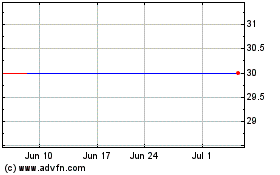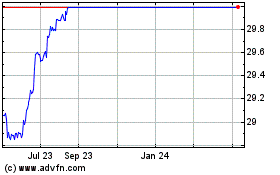One lesson: Not always relying on official statistics
By Simon Constable
The chief executive officer of Amsterdam materials company AMG
Advanced Metallurgical Group NV, Heinz Schimmelbusch, once at the
center of a controversial derivatives trade that cost a staggering
$1.3 billion ( see related article), is back and bucking
commodities-market trends.
While other companies have suffered stock drops and cut
dividends, AMG shares have soared (up 33.5% in 2015) and the firm
paid its first dividend last year. Shares of rivals such as Rio
Tinto PLC, Alcoa Inc. and Glencore PLC, meanwhile, were
hammered.
Dr. Schimmelbusch and his team at AMG -- which makes lithium for
car batteries and heat-resistant coatings for jet engines, among
other things -- foresaw the commodities slowdown in 2012 and
started an austerity program to reduce capital expenditure and
working capital, and retire debt. Four years later, the firm is
debt-free and ready to expand.
In an interview, Dr. Schimmelbusch explained how the move has
paid off. Edited excerpts follow:
Spotting a discrepancy
WSJ: What did you see in the metals markets that others
didn't?
DR. SCHIMMELBUSCH: In 2012 we saw a discrepancy between what our
business partners were telling us about conditions in China and
what the official statistics said.
When we asked Chinese-company leaders what was going on they
said that they felt the official statistics didn't necessarily
reflect what was happening on the ground. They were also
pessimistic about the availability of bank loans to private
enterprises.
We then started to compare the import-export statistics, which
didn't seem to match with the gross-domestic-product announcements.
There were so many uncertainties about what was happening and it
didn't fit with the optimism that some of our colleagues in the
industry had.
We knew that Chinese long-term growth was the reason for the
commodity boom. If that was interrupted, the commodity boom would
be interrupted, and therefore we started the austerity drive as a
hedge against that.
The program reduced capital expenditure, shrank working capital
and we paid down our debt. We also reduced our risk positions by
entering into long-term contracts with our customers.
WSJ: Economists -- and you hold a Ph.D. in economics -- have a
terrible reputation for forecasting. How did you make sure that
your anecdotal evidence was correct?
DR. SCHIMMELBUSCH: Here on our board we have economist Steve
Hanke, and he is informed and knowledgeable about the global
currency markets and monetary policy. We compared notes on my
observations about China, and our views reinforced each other's.
[Prof. Hanke saw a credit crunch for China's private sector
developing, which augured a huge slowdown in that country.]
As part of the process, he ran a model on commodity markets and
market participants. We ended up pretty sure of ourselves.
WSJ: The markets for all commodities are volatile, but it's also
true that for your products it's more so. Would you explain why
that is?
DR. SCHIMMELBUSCH: The volatility of the price of critical
materials follows a certain pattern. When you have an increase in
demand, such as the demand for lithium for use in batteries, then
prices explode because the supply of the materials cannot increase
quickly enough to keep up with demand.
Eventually there will be an increase in the supply, and an
effort by the end users to use less of the materials. As that
happens, the price explosion comes to an end.
WSJ: Even if China's consumption of commodities doesn't rebound,
you see a sustained long-term demand for your products. Why?
DR. SCHIMMELBUSCH: Our success will be a function of long-term
technology trends, because we provide materials that enable these
technologies to work.
For instance, we produce graphite and lithium for batteries, and
titanium alloys tailored to the aerospace sector. When you are a
producer of titanium alloys you don't need China. You need the
aerospace industry, which is global. When you produce tantalum, you
are depending on the smartphone industry, which isn't regionally
defined.
Austerity to expansion
WSJ: AMG introduced its first dividend last year. Do you think
commodities markets have hit bottom?
DR. SCHIMMELBUSCH: Our balance sheet has improved enough to have
shareholders participate without disturbing our ability to finance
our growth plans.
The dividend also allows those asset managers who are restricted
to buying dividend-paying stocks to invest in our shares.
The important thing now is that we are changing from austerity
mode to an expansion strategy because we feel the opportunities are
pretty obvious. We are currently deeply involved in an expansion of
our lithium resource in Brazil, partly because the price for the
metal is spiking and growth in demand is stable. The lithium we own
was a byproduct of tantalum production, which is used in
smartphones. The huge benefit here is that much of the extraction
costs for the lithium have been covered by the tantalum mine.
WSJ: The mining and metals industry has a reputation of being
dirty; you see it as green. Please explain.
DR. SCHIMMELBUSCH: Our products enable the aerospace industry to
coat turbine blades with ceramics, which provide a thermal barrier
coating. It means the nickel-alloyed engine blades can be used at
higher temperatures, raising the fuel efficiency and reducing
emission of carbon-dioxide.
Other materials we produce, such as graphite and lithium, allow
for energy storage in batteries.
The same thing is true for titanium alloys, which can replace
nickel alloys in the engines. They are lighter-weight than nickel
alloy and very heat resistant.
Mr. Constable is a writer in New York. He can be reached at
reports@wsj.com.
(END) Dow Jones Newswires
June 06, 2016 02:48 ET (06:48 GMT)
Copyright (c) 2016 Dow Jones & Company, Inc.
Arconic (NYSE:ARNC)
Historical Stock Chart
From Mar 2024 to Apr 2024

Arconic (NYSE:ARNC)
Historical Stock Chart
From Apr 2023 to Apr 2024
